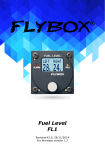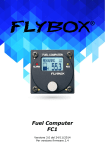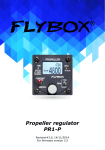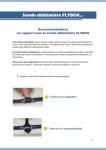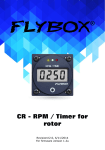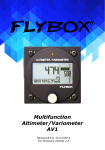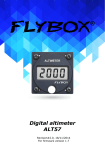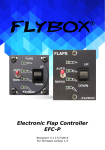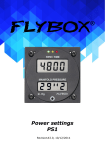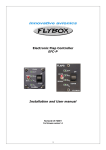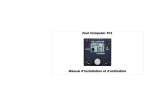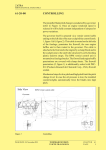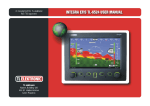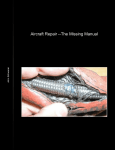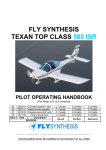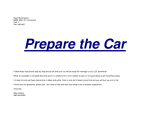Download Fuel Computer FC1 ® - Flybox Innovative Avionics
Transcript
FLYBOX ® Flybox ® Fuel Computer FC1 Revision#3.0, 25/11/2014 FC1 - User’s manual For firmware version 2.4 Rev. 3.0 Page intentionally left blank SECTIONS MECHANICAL INSTALLATION ELECTRICAL INSTALLATION OPERATING INSTRUCTIONS INSTRUMENT SETTINGS TECHNICAL SPECIFICATIONS FLYBOX® Introduction Thank you for purchasing a Flybox® product. We hope it fully satisfy you and makes your flights pleasant and secure. Developing FC1, our intent was to create a compact and lightweight fuel computer, easy to install and use. SYMBOLS USED IN THE MANUAL NOTE: Used to highlight important informations. CAUTION: Used to warn the user and indicate a potentially hazardous situation or improper use of the product. WARNING: Used to indicate a dangerous situation that can cause personal injury or death if the instruction is disregarded. FC1 - User’s manual Rev. 3.0 FLYBOX ® Important notices & warnings NOTE: Keep this manual in the aircraft. This document must accompany the instrument in the event of change of ownership. NOTE: This device is intended for installation onto non type certified aircraft only, because it has no aviation certifications. Refer to your local aviation authorities to check if this device may be installed in your aircraft. CAUTION: Read entirely this manual before installing the instrument in your aircraft, and follow the installation and operating instructions described here. CAUTION: The pilot must understand the operation of this instrument prior to flight, and must not allow anyone to use it without knowing the operation. Don't use this instrument in flight until you are sure of the correct operating of the same. CAUTION: When the installation is finished you must do a test, prior to flight, switching on all the possible source of electric noise and checking the properly operation of this instrument. CAUTION: The software of this instrument can be subject to change, update, addition or removal of functions, so also the operating mode of the instrument can be subject to change. Always refer to the installation and operating manual updated with the software version used in your instrument. To obtain updated manuals, please visit www.flyboxavionics.it. FC1 - User’s manual Rev. 3.0 Important notices & warnings FLYBOX® WARNING: This instrument should never be used as a primary instrument to determine the fuel tanks level; always refer to the original fuel level indicators of your aircraft. WARNING: Responsibility for installation lies entirely with the installer. Responsibility for operations lies entirely with the operator. Responsibility for any calibration, settings or any other customization lies with the person performing these operations. IMPORTANT: If you do not agree with the notices above do not install this instrument in your aircraft, but return the product for a refund. Microel s.r.l. reserves the right to change or improve its products. Information in this document is subject to changes without notice. FC1 - User’s manual Rev. 3.0 FLYBOX ® Index INDEX SECTION 1 - Mechanical installation 1.1 - Mechanical installation …….…………………………….. 1.2 - Flybox TFTHP fuel flow transducer installation ………… 8 10 SECTION 2 - Electrical installation 2.1 - Electrical installation …….………..………………….….. 13 SECTION 3 - Operating instructions 3.1 - Minimum settings before first use …….….………..…..… 15 3.2 - Panel indicators & commands .…………………………… 16 3.3 - Use of the instrument .……………………………….…… 17 SECTION 4 - Instrument settings 4.1 - Functions menu .…..….….……….………….…..………. 4.2 - Setup menu .….….………….…………..….………….…. 4.3 - Fuel flow transducer calibration …………….…………… 21 24 27 SECTION 5 - Technical specifications …….………….………. 29 Warranty …….………………………..………….……………. 30 FC1 - User’s manual Rev. 3.0 FLYBOX® Mechanical installation SECTION 1 1.1 MECHANICAL INSTALLATION The FC1 fits in a standard 2 1/4” panel cutout; it's recommended to choose a position that permits optimal display visibility. It's furnished with four M4 screws to install it to the panel, if you use other screws consider that the maximum thread length inside the FC1 panel is 15mm (see following picture). 8 FC1 - User’s manual Rev. 3.0 FLYBOX ® Mechanical installation All dimensions are in millimeters. FC1 - User’s manual Rev. 3.0 9 Fuel flow transducer installation FLYBOX® 1.2 FLYBOX TFTHP FUEL FLOW TRANSDUCER INSTALLATION If with the fuel computer FC1 it's used the Flybox TFTHP fuel flow sensor, read completely this section, otherwise refer to the installation and use instructions of the sensor used. The TFTHP flowmeter is developed to measure low range (3.6~120 l/hour) of fuel flow with high resolution output. It has high chemical resistance to aggressive liquids and hydrocarbons. The case can be opened for periodic monitoring and eventual replacement of the tube. RECOMMENDATION OF INSTALLATION AND USE: - Check flow direction (arrow on sensor). - Never clean the sensor with compressed air. - Install a filter in the fuel line before the sensor. - To mount the rubber tubes, use a drop of oil. - The tubes before and after the sensor should be straight for at least 5 cm. - Connection of fuel flow are suitable for 6 mm tubes. 10 FC1 - User’s manual Rev. 3.0 FLYBOX ® Fuel flow transducer installation - Use only spring band clamps of the type depicted here, with the appropriate diameter, in order to avoid deformation of the plastic fittings: - Protect the sensor from high temperature with a firesleeve material. - Check for leakage after system start. - Inspect the fuel sensor every year or every 50 hours of aircraft use for leakage and aging. To inspect and clean the sensor, open it, remove the sensor tube from the fuel system and look inside the two fittings to check for material integrity, aging and deformation. In case of any anomaly of the sensor tube, it must be replaced. Verify that the sensor tube is clean and without any obstruction. If necessary clean with a flow of fuel in the opposite direction. - The fuel flow transducer must be installed before the carburetor and after the eventual return line (Vapor lock). - Don't fix it mechanically to the airplane structure to avoid vibrations damage. - Mount the transducer lower than the carburetor, or no more higher than 10 cm every 30. FC1 - User’s manual Rev. 3.0 11 Fuel flow transducer installation FLYBOX® ELECTRICAL CONNECTIONS: RED WIRE: +12V (connect to pin 15 of the FC1 connector). BLACK WIRE: GND (connect to pin 5 of the FC1 connector). WHITE WIRE: signal connector). (connect to pin 10 of the FC1 CAUTION: After completing the installation verify that the engine is working properly at every RPM speed; verify also that at full RPM the fuel pressure after the fuel flow transducer never drop below the minimum pressure indicated in your engine's manual. ● Typical example installation of the fuel flow transducer: 12 FC1 - User’s manual Rev. 3.0 FLYBOX ® Electrical installation SECTION 2 2.1 ELECTRICAL INSTALLATION On the back of the FC1 there is a 15-pole male connector; it is also furnished with the corresponding 15-pole female connector, to be wired as follows: 15-pole female connector, view from wiring side FC1 - User’s manual Rev. 3.0 13 FLYBOX® Electrical installation Connector pinout: 1= +12V Main supply. 2= GND auxiliary backup battery (if present). 3= GND (not used). 4= GND for audio out. 5= GND for fuel flow transducer (black wire of Flybox TFTHP). 6= GND for GPS signal. 7= reserved. 8= GND Main supply. 9= +12V auxiliary backup battery (if present). 10= Input signal from fuel flow transducer (white wire of Flybox TFTHP). 11= Alarm out (300mA max). Connect the load (for example a lamp indicator) between out and +12V. 12= Audio out for intercom (it's recommended to use shielded cable). 13= reserved. 14= Input signal from GPS (GPS TX). 15= +12V for fuel flow transducer (red wire of Flybox TFTHP). NOTA: Insert a 1A circuit breaker or fuse to the power lead.(+12V). Take care to properly insulate any exposed wire, to avoid short circuit between any of the wires. CAUTION: Voltage peaks that exceeds the operating limits on the supply line can damage the device. 14 FC1 - User’s manual Rev. 3.0 FLYBOX ® Minimum settings before first use SECTION 3 3.1 MINIMUM SETTINGS BEFORE FIRST USE CAUTION: Before using the FC1 in flight for the first time you must set at least the following parameters (reading the operating instructions in the following pages): ● Set the unit of measure: USgallons or liters (set this before all the other parameters). ● Set the unit of measure: kilometers or nautical miles. ● Set the tank/s capacity. ● Set the nominal K-factor of the fuel flow transducer installed. For example if you use the Flybox TFTHP fuel flow transducer the K-factor is 416400 (in gallons) or 110000 (in liters); if you use other types of transducer set the relative K-factor. ● To have reliable indications it's required to perform the fuel flow calibration right after you finish the installation (see chap.4.3). FC1 - User’s manual Rev. 3.0 15 Panel indicators & commands FLYBOX® 3.2 PANEL INDICATORS & COMMANDS Reserve LED Alarm LED Knob with pushbutton The knob can be rotated or used as a pushbutton (for example it must be rotated to increment or decrement a value and pushed to confirm). 16 FC1 - User’s manual Rev. 3.0 FLYBOX ® Use of the instrument 3.3 USE OF THE INSTRUMENT At startup the display briefly shows the software version, then it appear a screen that permits to “inform” the FC1 if you have refuelled the tank/s: ● NO REFUELLED: Select this option and confirm (press the knob) if you don't have refuelled the tank/s. ● ADD FUEL: Select this option if you have added fuel to the tank/s. After pressing the knob it appear a screen that permits to insert the exact quantity of fuel (rotate the knob to increment/decrement the value and press to confirm). ● FILLED: Select this option if you have filled the tank/s. Before using this option you must have set the tank/s capacity in the FC1 (see chapter 4.2 “Setup menu”), so that the FC1 can automatically set the quantity. The display shows a confirmation screen that indicates the amount of fuel that has been added to reach the full level. FC1 - User’s manual Rev. 3.0 17 FLYBOX® Use of the instrument If you choose the wrong option or insert a wrong quantity of fuel it is possible to correct the quantity of fuel in the tank/s (see option “REMAINING” in chapter 4.2 “Setup menu”). If you begin the flight without choosing any of the three options you can do this later because the FC1 measure anyways the fuel flow (of course only if the FC1 is turned on). CAUTION: Before begin a flight check that the remaining fuel indicated by the FC1 correspond to the level indicated by the televel. Now the FC1 is operative and it shows the first of the six available indicator screens; rotate the knob to scroll between the six screens in this order: FLOW → REMAINING → BURNED → ENDUR → RANGE → RESERVE 18 FC1 - User’s manual Rev. 3.0 FLYBOX ® Description of indications DESCRIPTION OF AVAILABLE INDICATIONS: Display the fuel flow. According to the selected unit of measure the flow is indicated in liters per hour (Lt/h) or gallons per hour (USg/h). Display the fuel remaining in the tank/s. According to the selected unit of measure the flow is indicated in liters (Lt) or gallons (USg). CAUTION: The fuel remaining displayed here is not a measurement of the fuel in the tank/s, but it is calculated from the initial quantity and the burned quantity measured from the fuel flow transducer. Display the fuel burned from the turn-on. According to the selected unit of measure the flow is indicated in liters (Lt) or gallons (USg). Display the time to empty, calculated considering the fuel remaining and the actual fuel flow. If it is not possible to calculate the time to empty (for example when the engine is turned off) the display shows --:-- FC1 - User’s manual Rev. 3.0 19 Description of indications FLYBOX® Display the range calculated considering the fuel remaining, the actual fuel flow and the ground speed furnished by the GPS. NOTE: if the display shows “NO GPS FIX” it can means that the GPS is not connected, turned off or don't have the fix. If it is not possible to calculate the range (for example when the engine is turned off) the display shows ---. Display the fuel remaining at destination; the destination is intended as the approaching GPS waypoint. If the number is negative it means that there is not enough fuel to reach the destination. NOTE: if the display shows “NO GPS FIX” it can means that the GPS is not connected, turned off or don't have the fix. If it is not possible to calculate the reserve (for example when the engine is turned off) the display shows --.-. 20 FC1 - User’s manual Rev. 3.0 FLYBOX ® Functions menu SECTION 4 4.1 FUNCTIONS MENU To enter in the functions menu, press the knob for at least one second; the menu is divided in two pages. Turn the knob to switch from one page to the other. Each menu items can be selected by pressing the knob, and once selected you can change its value by turning the knob and then press again to confirm and store the new value. Functions menu - page 1 Done: exit from the main menu and return to the indicator screens. Cicling: start/stop the automatic cicling between the six indicator screens. This function alternatively display the desired screens for a certain amount of time (see “Cicling time” and “Cicling screens” in the Setup menu to set the desired time and screens). To stop this function when it is activated, simply rotate the knob. FC1 - User’s manual Rev. 3.0 21 FLYBOX® Functions menu Q.ty warning: Set the fuel quantity for the low fuel warning: when the fuel remaining reaches this setpoint the FC1 activate an alarm (blinking red LED and audio tone in the audio out). Also the Reserve LED will turn-on to indicate the low fuel condition. To deactivate the alarm rotate or press the knob. To disable this function set the value to zero. Time warning: Set the time to empty warning: when the time to empty reaches this setpoint the FC1 activate an alarm (blinking red LED and audio tone in the audio out). To deactivate the alarm rotate or press the knob. To disable this function set the value to zero. Functions menu - page 2 Balancing: This function is useful to keep balanced two wing tanks, switching from one to the other after using a certain quantity of fuel. The FC1 will activate an alarm every time the quantity of fuel used equals this value, showing “TANK BALANCE” on the display, blinking the red LED and activating the audio out. To deactivate the alarm rotate or press the knob. To disable this function set the value to zero. 22 FC1 - User’s manual Rev. 3.0 FLYBOX ® Functions menu Light: Turns on/off the display backlight. Setup: enter the setup menu (see next chapter). FC1 - User’s manual Rev. 3.0 23 FLYBOX® Setup menu 4.2 SETUP MENU Setup menu - page 1 Done: Exit from the setup menu and return to the indicator screens. Contrast: adjust the LCD contrast. Cicling time: Set the time interval, from 1 to 10 seconds, for the “Cicling” function (see previous chap. “Functions menu”). Cicling screens: Set which screens to show when using the “Cicling” function (see previous chap. “Functions menu”). Press the knob to display a screen that permits the individual selection of the six indication screens; select “Done” to exit. Setup menu - page 2 Audio volume: Adjust the volume for the audio out (min=1 max=8). 24 FC1 - User’s manual Rev. 3.0 FLYBOX ® Setup menu K factor: Manually set the transducer K-factor (K-factor = number of electrical pulses for each liter or gallon that flows through the transducer). To modify the value keep pressed the knob for 3 seconds. According to the selected unit of measure the K-factor is indicated in pulses per liters or pulses per gallons. Autocalibration K: see chapter 4.3 “Fuel flow transducer calibration”. Tank capacity: Set the tank capacity (if there are more than one tank set the total capacity of the tanks). Setup menu - page 3 Fuel unit: Set the unit of measure in liters or US Gallons (keep pressed the knob for 3 seconds to modify the value). NOTE: Switching from one unit of measure to the other affect also the parameters that is expressed using this unit of measure: Tank capacity, Fuel remaining, K-factor, so you must check that this parameter are correct after setting the unit of measure. FC1 - User’s manual Rev. 3.0 25 FLYBOX® Setup menu Space unit: Set the unit of measure in kilometers or nautical miles. GPS: Enable the GPS and the two indications that need it (RANGE and RESERVE); you must correctly connect the GPS to use this features. GPS baud: Set the GPS communication speed (Default = 4800bps). NOTE: The required GPS sentences are: $GPRMC and $GPRMB. Check that the GPS is set to transmit this sentences. Setup menu - page 4 Filter: (Keep pressed the knob for 3 seconds to modify this value). To remove fluctuation or jump in the fuel flow readings increase this value; viceversa decrease the value if the fuel flow display update is too slow (Default = 40). The filter will not affect the accuracy of the FC1, it apply only to the displayed value of the fuel flow. Remaining: Manually set the remaining quantity of fuel in the tank/s. Keep pressed the knob for 3 seconds to modify this value. 26 FC1 - User’s manual Rev. 3.0 FLYBOX ® Fuel flow transducer calibration 4.3 FUEL FLOW TRANSDUCER CALIBRATION CAUTION: The fuel flow calibration (K-factor of fuel flow transducer) is essential to have reliable indications from the FC1. The instruments, as factory default, is set to have the nominal K-factor of the Flybox TFTHP transducer. Whether using this transducer, whether using other types of transducer, it’s required to perform the calibration right after you finish the installation. It's also recommended to repeat it once a year. The calibration procedure is the following: 1. With the aircraft in level fill the tank/s of fuel; note that in the step #4 it's required to refuel the tank/s at the exact level reached here. 2. Turn-on the FC1 and select “FILLED”. 3. Start a flight and burn at least half quantity of fuel in the tank/s: a greater amount of burned fuel will increase the accuracy, and you can do this step in more flight: at the start of the next flights you must not add fuel in the tank/s and you must select “NO REFUELLED” after turning on the FC1. 4. Now fill the tank/s with the exact same level reached in the step #1, accurately measuring the quantity of fuel added in the tank/s. FC1 - User’s manual Rev. 3.0 27 Fuel flow transducer calibration FLYBOX® 5. Turn on the FC1, select “NO REFUELLED” (even if you have added fuel is required to select “NO REFUELLED”) and go to the option “Autocalibration K” in the Setup menu; keep pressed the knob for 3 seconds to enter in the calibration. Now the display shows “QUANTITY TO FILL” with a number: this number should be equal to the quantity of fuel that you have added and measured in the step #4; probably it doesn't correspond exactly because the transducer is still not calibrated and you must modify the value rotating the knob. 6. Press the knob to confirm the value inserted and the display will shows the new calculated K-factor. Now the transducer is calibrated. NOTE: it's recommended to annotate this value so that if you inadvertently modify the K-factor it's possible to manually modify it without doing again the calibration. 28 FC1 - User’s manual Rev. 3.0 FLYBOX ® Technical specifications SECTION 5 5.1 TECHNICAL SPECIFICATIONS ● Graphic LCD with backlight and coated glass, dimensions 29x18mm. ● Standard mounting 2 1/4” (57mm). ● Anodized aluminium case. ● Dimensions: 60.0 x 60.0 x 52.6 mm. ● Weight: 175g. ● Operating temperature range: -10 ~ +70°C. ● Supply voltage: 12 ~ 15 V=. ● Supply current: 75 mA. ● Audio level output: 2Vpp (with 10Kohm load). ● Alarm output: open-collector, 300mA max current, active low. ● GPS input: RS-232 standard, data format: NMEA-0183 (4800/9600/19200/38400bps), sentences required: $GPRMC and $GPRMB. ● Fuel flow resolution: 0.1 liter per hour. ● Burned/remaining fuel resolution: 0.1 liter. FC1 - User’s manual Rev. 3.0 29 FLYBOX® WARRANTY: This product is warranted to be free from defects for a period of 12 months from the user invoice date. The warranty only cover the manufacture's defects; shall not apply to product that has been improper installed, misused or incorrect maintenance, repaired or altered by non-qualified person. Date 07/2009 09/2010 05/2013 07/2013 11/2014 Revision 20 21 22 23 30 Description Updated with new Flybox fuel flow transducer Updated installation note Updated with “GPS baud” parameter Updated fuel flow tranducer note Layout update WARNING: All photos, data, drawings, instruments layouts, technical solutions and data representation you find in this document or watching at FLYBOX® instruments working and/or you can access by means of any other media, including web sites, are sole property of MICROEL s.r.l., cannot be copied or imitate without a written permission of MICROEL s.r.l. itself and are protected by law, even by means of extended international copyright and/or specific patents deposited. Any infringement of this statement and of MICROEL s.r.l. intellectual property will be prosecuted. ©2014 Microel s.r.l. – all rights reserved. 30 FC1 - User’s manual Rev. 3.0 Page intentionally left blank MICROEL s.r.l. Via Mortara 192-194 27038 Robbio (PV) - ITALY Tel +39-0384-670602 - Fax +39-0384-671830 www.flyboxavionics.it
































